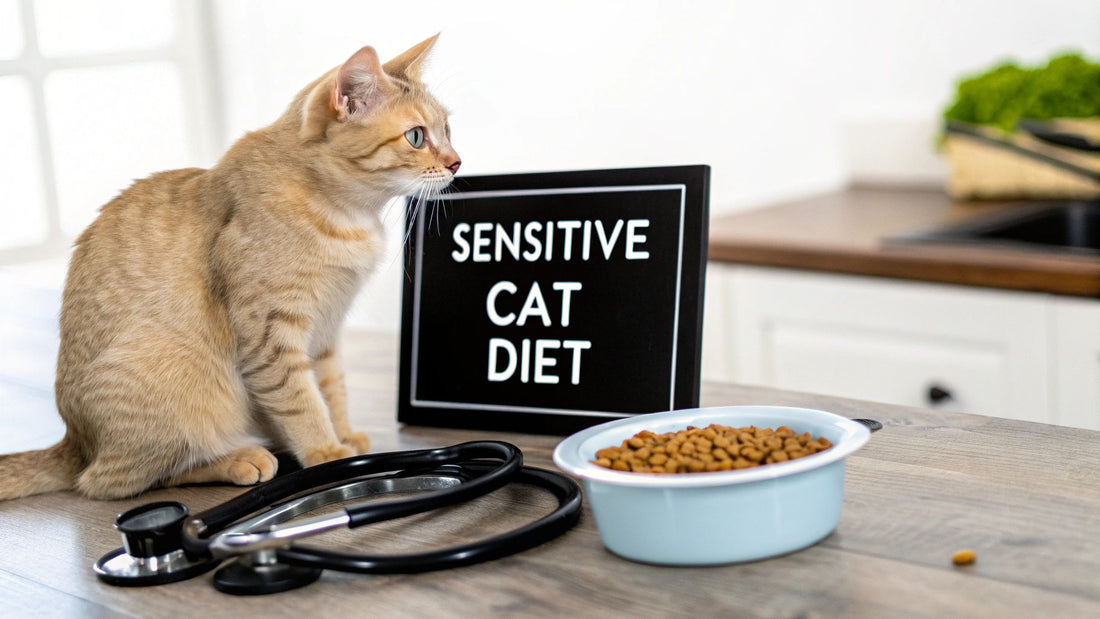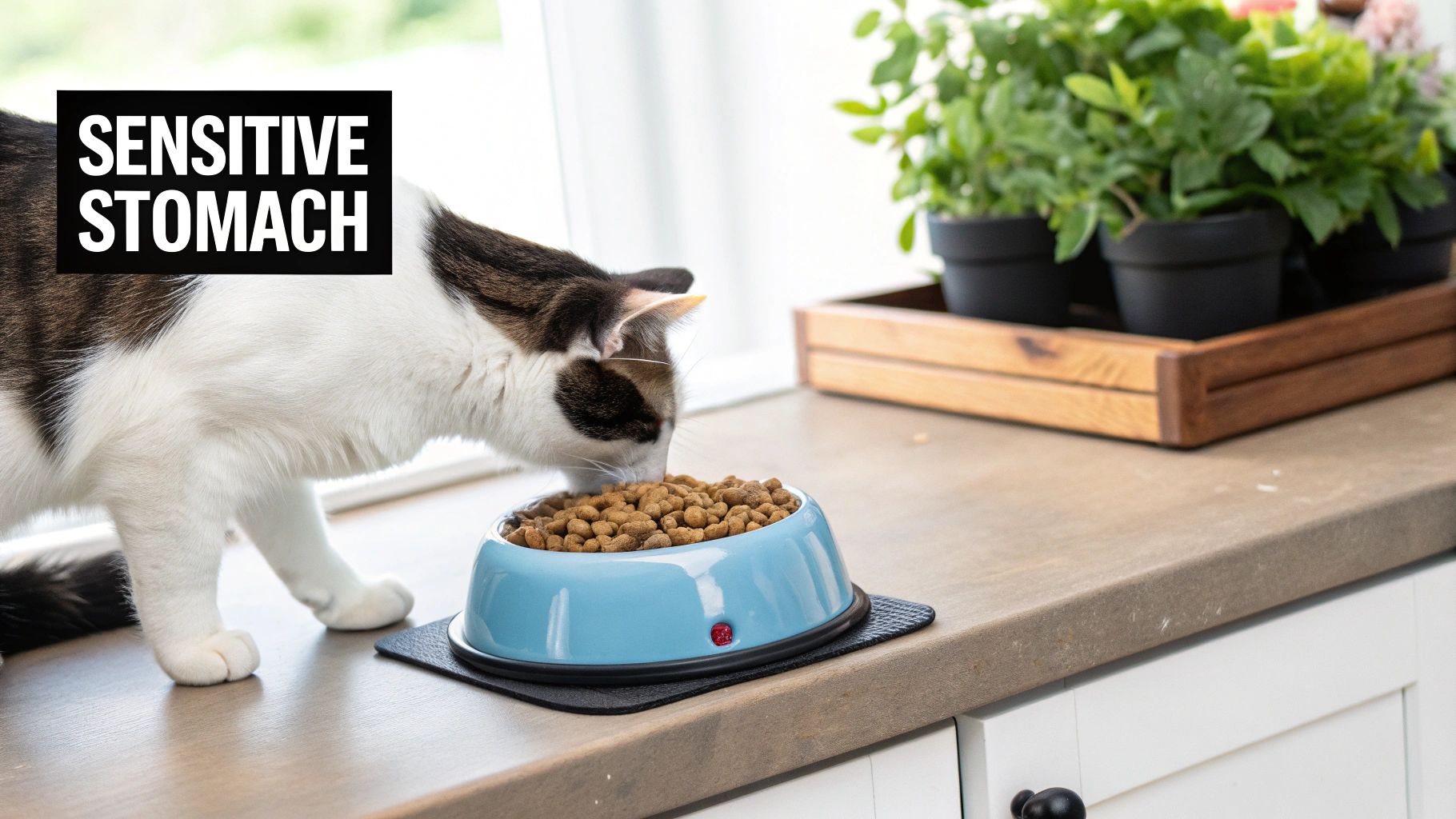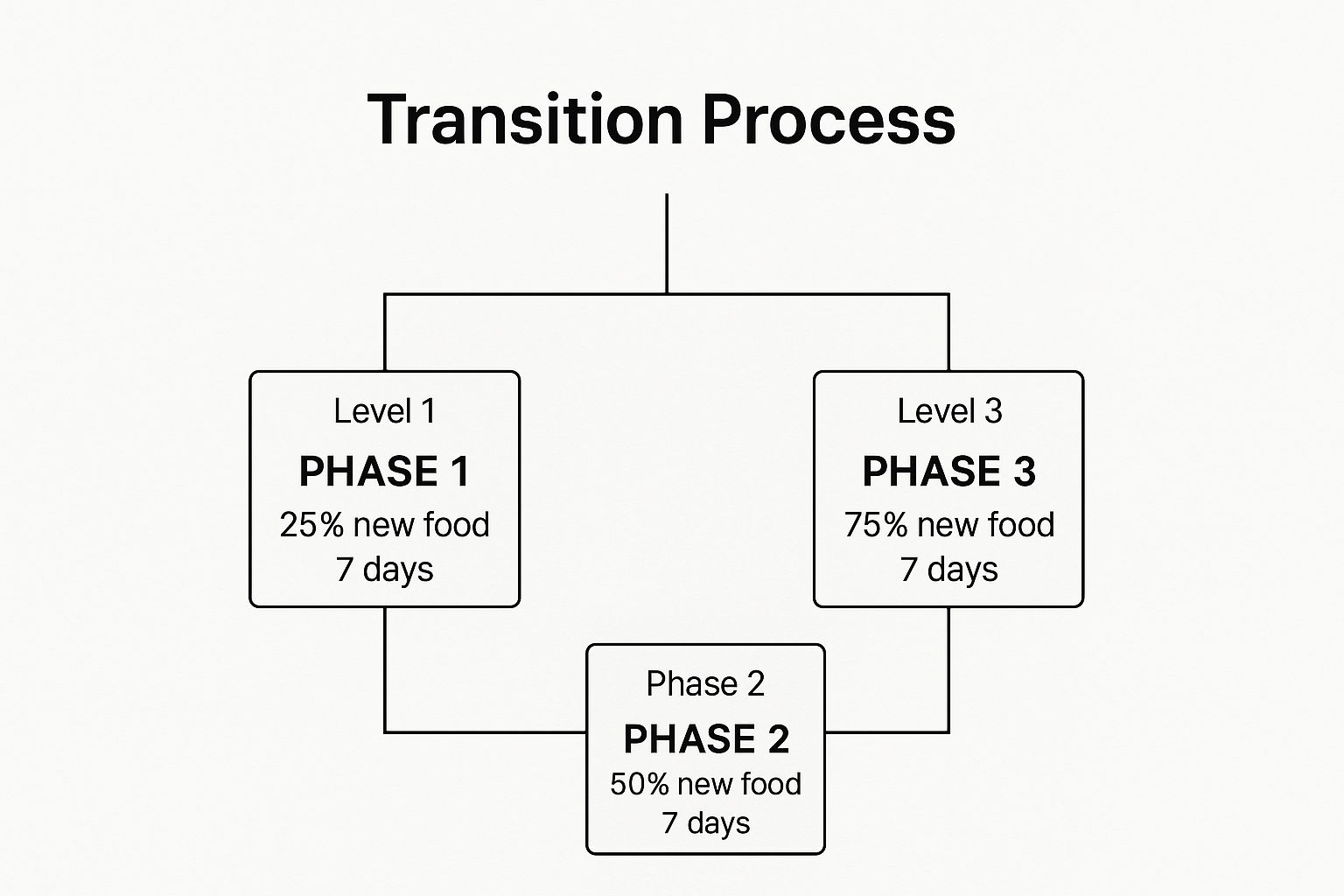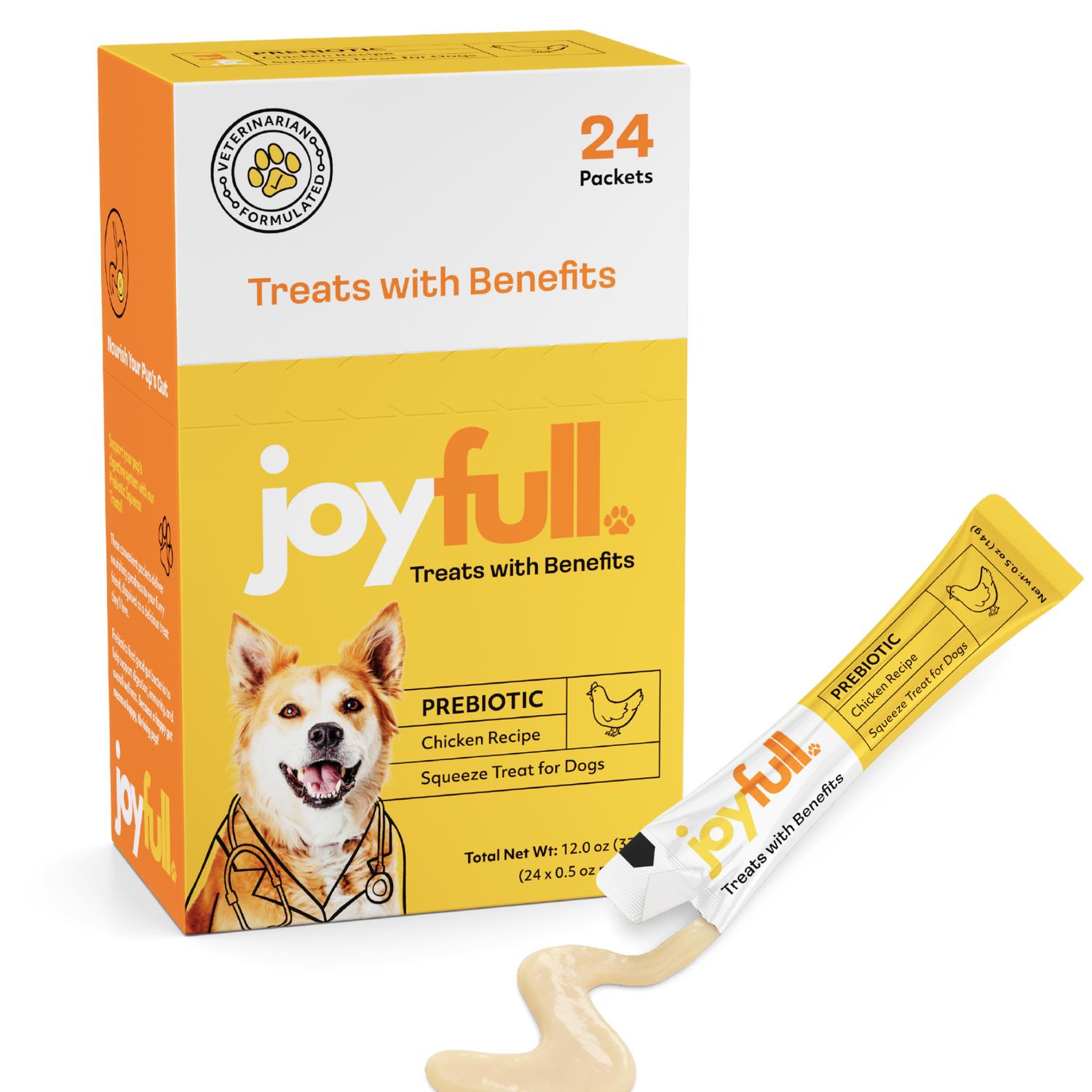
Finding the Best Cat Food for Sensitive Stomachs
When your cat has a sensitive stomach, the right food makes all the difference. The best formulas usually center on a single, novel protein source—think duck or rabbit—that’s easy for them to digest. They also steer clear of common agitators like corn, wheat, and artificial junk, often adding in gentle fibers and prebiotics to help get their gut back on track.
Is Your Cat's Stomach Really Sensitive?
It's a question I hear all the time from cat owners. Was that just a hairball, or is the constant spitting up a sign of something bigger? Figuring out if you’re dealing with a random upset tummy or a true, chronic sensitivity is the first real step to helping your cat feel better.

Think of your cat's digestive system like a finely tuned engine. When every part is working correctly, it just hums along quietly. But if you put the wrong kind of fuel in—like an ingredient that doesn't agree with them—the whole system can start to sputter and knock, leading to some pretty obvious signs of trouble.
Spotting the Subtle Signs
Of course, the most glaring red flags are vomiting and diarrhea. A single episode might not be a huge deal, but if it's happening over and over, that's your cat's body screaming that something is wrong. But the signs of a sensitive stomach aren't always that dramatic.
Sometimes, the clues are much quieter. You have to put on your detective hat and watch your cat's daily routine and physical state for patterns. These less obvious signs can include:
- Excessive Gas: It's not the most glamorous topic, but if your cat is suddenly extra gassy, it’s a classic sign of digestive upset.
- Changes in Appetite: Is your usually ravenous cat now a picky eater? A sudden loss of interest in food can mean they're starting to associate mealtime with feeling crummy.
- Poor Coat Condition: A dull, flaky, or greasy coat can be an outward sign of an internal problem. If they can't absorb nutrients properly, their skin and fur are often the first places you'll see it.
- Weight Loss: If the numbers on the scale are going down even though your cat is eating, their body likely isn't getting the nutrition it needs from their food.
A sensitive stomach isn't just about what happens in the gut; it impacts your cat's entire quality of life. Pinpointing these symptoms early lets you draw a clear line between their diet and their discomfort, so you can start making changes.
Here's a quick reference to help you connect the dots between what you're seeing and what might be causing it in their food bowl.
Quick Guide to Sensitive Stomach Symptoms and Causes
| Symptom to Watch For | Common Dietary Culprit |
|---|---|
| Vomiting or Diarrhea | Common proteins (chicken, beef), grains (corn, wheat), dairy, or artificial additives. |
| Excessive Gas/Flatulence | Hard-to-digest fillers like corn or soy, or a sudden change in diet. |
| Picky Eating/Appetite Loss | The specific flavor or texture might be associated with discomfort, or an ingredient is causing nausea. |
| Dull Coat or Flaky Skin | Lack of absorbable nutrients, often due to fillers that offer little nutritional value. |
This table isn't for diagnosing, but it can help you spot patterns that are worth discussing with your veterinarian.
Why It's a Common Concern
If you think your cat is struggling with digestive issues, you're definitely not alone. Some reports show that up to 30% of domestic cats have some form of food sensitivity or digestive trouble, which is why there's been such a big boom in specialized cat foods. This trend is explored in detail in recent market research on sensitive stomach cat food.
Catching these signs is the most important first step. Once you move past the guesswork, you can make an informed choice about the best food for your cat's sensitive stomach and get them back to feeling happy and healthy.
Decoding the Cat Food Label for Gut Health
Staring at the cat food aisle can be overwhelming, right? It feels like a wall of confusing choices, with every bag promising a miracle. But here’s the secret: the ingredient label is your best friend and your most powerful tool. Learning how to read it is the key to finally finding the best cat food for sensitive stomachs.
Think of the ingredient list like a recipe, where the most plentiful ingredients are always listed first. Your mission is to find a recipe built on high-quality, easy-to-digest foods—not one stuffed with cheap fillers and things that could upset your cat's system.
The Heroes of Gut Health
When you pick up a bag, your eyes should immediately scan for a few key "hero" ingredients. These are the components known for being gentle and supportive for a cat’s digestive system.
- A Named, High-Quality Protein First: The number one ingredient should be something specific and clear, like "deboned duck" or "rabbit." You want to avoid vague descriptions like "meat by-products," because that tells you nothing about the actual source.
- Novel Proteins: For a surprising number of cats, the classic proteins like chicken and beef are actually the problem. A novel protein is just one your cat has likely never tried before—think venison, duck, or rabbit. This simple switch can often sidestep an allergic reaction altogether.
- Gentle, Functional Fibers: Look for ingredients like pumpkin, sweet potato, or beet pulp. These aren't just fillers; they provide both soluble and insoluble fiber, which helps create well-formed stool and keeps the digestive system moving along smoothly.
- Prebiotics and Probiotics: These two are the absolute superstars for gut health. Prebiotics, like chicory root, act as fuel for the good bacteria already living in your cat's gut. Probiotics, which you might see listed as a "dried fermentation product," are the actual beneficial bacteria that help create a balanced internal ecosystem.
Think of your cat’s digestive tract as a garden. Probiotics are the new, healthy seeds you plant. Prebiotics are the fertilizer that helps those good seeds grow strong and crowd out all the weeds.
The Villains to Avoid
Knowing what to look for is only half the battle. You also need to know which ingredients to run from. Certain common additives are notorious for causing flare-ups in cats with delicate systems, so if you see these high up on the list, it's a major red flag.
- Common Grain Fillers: Corn, wheat, and soy are popular in pet foods because they're cheap, but they can be very difficult for many cats to digest. They’re also common culprits behind food allergies.
- Artificial Additives: Keep an eye out for artificial colors, flavors, and preservatives like BHA, BHT, and ethoxyquin. They bring zero nutritional value to the table and can be significant triggers for digestive problems.
- Unnamed Protein Sources: If the label says "meat and bone meal" or "animal digest," put the bag back on the shelf. There’s no way to know what animal that protein came from, which makes it impossible to pinpoint or avoid potential allergens.
- Dairy and High-Fat Meats: Just like many people, most adult cats are lactose intolerant. Dairy is a recipe for digestive disaster. Similarly, super fatty proteins like beef can sometimes be too rich for a sensitive stomach to process properly.
Once you know what you’re looking for, reading a label goes from being a chore to a skill. By focusing on simple, whole-food ingredients you can actually recognize, you’ll be able to confidently pick out a food that will help your cat feel their best. For an even deeper look into ingredient lists, our guide on how to choose cat food breaks down all the essentials.
Wet Food Versus Dry Food for Digestive Issues
It's the classic debate every cat owner has in the pet food aisle. But when you're dealing with a sensitive stomach, the choice between wet and dry food feels a lot more critical. This isn't just about what your cat prefers to eat; it’s about what their gut can actually handle. And honestly, there's no single right answer—both have their own perks for a delicate digestive system.

The most obvious win for wet food is its high moisture content. Cats are notoriously poor drinkers; they just don't have a strong natural thirst drive. Wet food is a fantastic way to sneak more water into their diet, which helps keep stools soft and supports kidney and urinary health. A hydrated cat is often a cat with a happier digestive tract.
Plus, its soft, pate-like texture is simply easier to break down. For a gut that's already working overtime, that gentler consistency can be a huge relief.
The Case for Specialized Dry Food
Don't count kibble out just yet, though. We're not talking about just any bag of dry food off the shelf. Modern formulas designed for digestive care are in a different league entirely.
These specialized kibbles are often engineered with highly digestible proteins, prebiotics to feed good gut bacteria, and specific fiber blends that can help firm up loose stools. They pack a lot of targeted nutrition into a crunchy, convenient package. The long shelf life and ease of feeding make dry food a practical staple in many homes. While wet food is gaining popularity for its hydration, market analysis shows dry food still commands a huge portion of the sensitive stomach category. You can actually dig into the cat food market dynamics on Future Market Insights to see the trends.
The Takeaway: The "best" choice really comes down to your individual cat. A constipated kitty might do wonderfully with the extra moisture from wet food, while another with chronic diarrhea could find relief from the specific fibers in a digestive-care kibble.
Finding a Happy Medium with Mixed Feeding
So, why not get the best of both worlds? Many vets are now recommending a strategy called mixed feeding, which is exactly what it sounds like: a combination of wet and dry food. This approach delivers the hydration and appealing taste of wet food while still giving you the convenience and dental benefits of kibble.
It often looks something like this:
- Morning Meal: Start the day with a serving of wet food for a big hydration boost.
- Daytime Grazing: Leave out a carefully measured portion of their special dry food for them to nibble on.
- Evening Meal: Round out the day with another meal of wet food.
This balanced method can be a game-changer for managing a sensitive stomach. It covers all the nutritional bases while catering to your cat's health needs and their picky palate.
Navigating Specialized Cat Food Diets
When you start looking for cat food for a sensitive stomach, you’ll run into a wall of confusing terms. "Limited Ingredient Diet," "Grain-Free," "Hydrolyzed Protein"—it can feel a bit overwhelming.
Don't let the technical labels fool you. Think of these as different tools in a toolbox, each designed to solve a specific digestive problem. Once you understand what each one does, you can cut through the marketing noise and find what will actually help your cat feel better.
It’s a bit like being a detective for your cat’s diet. Each specialized formula gives you a new clue to figure out what’s causing the tummy trouble.
Limited Ingredient Diets (LID)
The most direct approach is a Limited Ingredient Diet, often called an LID. The whole point is to dramatically simplify your cat's meals, cutting down the number of things that could potentially be causing a reaction.
An LID recipe usually has just one source of animal protein, like turkey or rabbit, and only one or two easy-to-digest carbs, like green peas or sweet potatoes. It’s a clean, minimal formula.
This simplicity is what makes it the perfect starting point for an elimination diet. By switching to an LID, you create a safe baseline. If your cat’s symptoms clear up, you’ve confirmed that something in their old food was the culprit, making it much easier to pinpoint the problem ingredient.
By simplifying what goes into your cat’s bowl, you can more easily identify what’s causing the irritation. It’s about creating a calm, predictable environment for their digestive system to heal and reset.
Grain-Free Formulas
Grain-free food is everywhere these days, and for good reason. Grains like corn, wheat, and soy are common fillers in cat food, but they can be tough for some cats to digest. For a cat with a grain sensitivity, cutting these out can provide almost immediate relief from issues like bloating and diarrhea.
But here’s a crucial point: "grain-free" doesn't automatically mean it's right for every sensitive cat. A cat can be allergic to the protein source, like chicken or beef, even if the food is grain-free. It's just one piece of the puzzle. For a closer look, check out our guide on other common cat food ingredients to avoid.
Hydrolyzed Protein Diets
Now we’re getting into the heavy-duty solutions. A hydrolyzed protein diet is typically the last stop, reserved for cats with severe food allergies or chronic conditions like Inflammatory Bowel Disease (IBD).
In these formulas, the protein molecules are broken down into pieces so small that the cat's immune system literally doesn't recognize them as a threat.

Think of it like a key that’s been filed down so much it can’t fit into any lock—that’s what happens to the protein. It becomes "invisible" to the allergic response. These diets are almost always prescribed by a vet after other options have been exhausted, as they provide complete nutrition without triggering an immune reaction.
Comparing Specialized Diets for Sensitive Cats
Choosing the right path depends entirely on your cat's specific issues. A cat who just gets a bit gassy after eating corn needs a very different solution than a cat with a severe, diagnosed allergy. This table breaks down the main options to help you see which one fits best.
| Diet Type | Primary Goal | Best For Cats With |
|---|---|---|
| Limited Ingredient | Simplify the diet to identify specific triggers through elimination. | Suspected food sensitivities or allergies to common proteins or additives. |
| Grain-Free | Remove common grain allergens like corn, wheat, and soy. | Known or suspected grain sensitivities; cats who get gassy or bloated from grain-heavy foods. |
| Hydrolyzed Protein | Make proteins "invisible" to the immune system to prevent allergic reactions. | Severe, persistent food allergies or diagnosed IBD that hasn't responded to other diets. |
Ultimately, a hydrolyzed diet is a powerful therapeutic tool for extreme cases, while LIDs are a fantastic diagnostic tool for most common sensitivities. Grain-free formulas are a great first step if you suspect grains are the problem.
So, you’ve put in the work, researched the options, and finally picked out the perfect new food for your sensitive cat. That's a huge step, but the job isn't quite done. If you just swap the old food for the new one overnight, you might accidentally trigger the exact digestive drama—vomiting, diarrhea, you name it—that you're trying to solve.
The secret is a slow and steady transition. Give your cat's gut a chance to get acquainted with the new menu.

Think about it this way: you wouldn't just throw a new player into the championship game without any practice. You'd ease them in, letting them learn the plays and get comfortable with the team. Your cat's gut microbiome—that whole community of tiny organisms handling digestion—needs the same gentle introduction to the new ingredients.
The Foolproof 7-Day Transition Plan
Patience is everything here. The most common mistake people make is rushing the process, which almost always ends in a digestive revolt. A slow, methodical approach is the best way to keep things peaceful. Most vets agree that a seven to ten-day schedule is the sweet spot for a safe switch.
Here’s a simple mixing guide to follow for every meal:
- Days 1-2: Start with a mix of 75% old food and 25% new food. This is just a little sneak peek, letting their system get a feel for the new recipe.
- Days 3-4: Move to a fifty-fifty split: 50% old food and 50% new food. Now they're getting a real taste of what's to come.
- Days 5-6: Time to tip the scales. Mix 25% old food with 75% new food. The new formula is officially the main course.
- Day 7 Onward: If your cat's digestion seems happy, you can go ahead and serve 100% new food.
The whole point is to make the change so subtle that your cat's digestive system barely notices. This gives the good bacteria in their gut time to adapt to the different proteins and fibers without getting overwhelmed.
What to Do If Things Go Sideways
Even with the most careful plan, some extra-sensitive cats might protest a bit, either by refusing the food or showing signs of a mild stomach upset. Don't worry. This is pretty common, and a few small tweaks can usually get you back on track.
- If your cat refuses the food: Some cats are just naturally suspicious of new smells and textures. If yours turns their nose up, simply take a step back. Revert to the previous ratio (for example, go back to the 25% new food mix) and stay there for another couple of days before trying to move forward again.
- If you see minor symptoms: A little bit of gas or slightly softer stool means their system is asking you to slow down. Just stretch out the transition. Instead of two days at each stage, try three or four. If the symptoms are more serious or don't go away, it's time to hit pause and give your vet a call.
Common Questions About Sensitive Stomach Cat Food
Diving into the world of digestive care for your cat can feel a little overwhelming. As you start trying to pinpoint the best cat food for sensitive stomachs, it's totally normal to have a few questions about what to expect, what certain labels mean, and when it’s time to call in the professionals. Let's tackle some of the most frequent concerns.
How Long Until I See Improvement on a New Cat Food?
We all want a quick fix, but a cat's digestive system needs time to adapt to a new diet. While you might spot some small, positive changes within the first week, it really takes a full 4 to 8 weeks for their gut to truly rebalance and for you to see the full effect of the new food.
Patience is your best friend during this trial period. To get a clear read on whether the new formula is working, you have to be strict—stick only to the new food and hold off on treats or table scraps. If two months go by with no real improvement, that's a solid sign it's time to talk to your vet about what to try next.
Think of it like starting a new fitness routine. You don't see major results after one trip to the gym. Consistent, dedicated effort over several weeks is what allows the body—or in this case, the gut—to adapt and strengthen.
Are Grain-Free and Hypoallergenic Diets the Same Thing?
This is a huge point of confusion for many pet owners, but these two labels are not interchangeable. Getting the difference is key to picking the right food.
- Grain-Free: This just means the recipe doesn't contain common grains like corn, wheat, or soy. It’s a great option if you know your cat has a specific issue with grains, but it won’t solve a protein allergy. A cat can still be allergic to the chicken in a grain-free food.
- Hypoallergenic: This kind of diet is formulated from the ground up to avoid triggering allergic reactions. It usually achieves this by using novel proteins (like rabbit or venison) that your cat has likely never eaten before, or hydrolyzed proteins that are broken down so small the immune system doesn't even recognize them as a threat.
So, while some foods might be both, a grain-free diet isn't automatically hypoallergenic.
Can I Still Give My Sensitive Cat Treats?
Yes, but you need to be incredibly careful. Most of the colorful, fun-shaped treats you see in stores are loaded with fillers, artificial additives, and vague "meat-by-product" ingredients that can easily derail all the progress you've made. They’re a very common culprit behind stomach upset.
Your safest option is to find single-ingredient treats that match your cat’s diet. For example, if your cat is on a new duck-based food, look for freeze-dried duck treats. This keeps the ingredients consistent. When in doubt, it’s always best to skip treats altogether, especially when you're in the middle of a food trial.
When Should I Take My Cat to the Vet for Stomach Issues?
Switching food can solve a lot of minor digestive problems, but some symptoms are red flags that shouldn't be ignored. It's time to call your vet if you notice any of these persistent issues:
- Frequent, chronic vomiting
- Diarrhea that just won’t go away
- Unexplained weight loss
- Lethargy or a sudden lack of energy
These can signal more serious underlying health problems, like Inflammatory Bowel Disease (IBD) or other conditions that need a veterinarian's diagnosis. Your vet can run the right tests to figure out what's really going on and get your cat on a proper treatment plan.
At Joyfull, we create formulas with clean ingredients and high-quality proteins because we believe a healthful life isn’t just for humans. Explore our commitment to pet wellness at https://joyfullpet.com.

